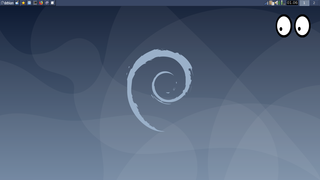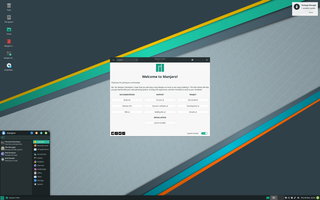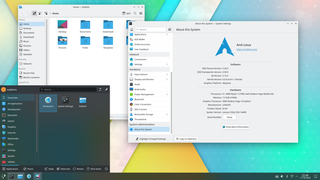In computing, a desktop environment (DE) is an implementation of the desktop metaphor made of a bundle of programs running on top of a computer operating system that share a common graphical user interface (GUI), sometimes described as a graphical shell. The desktop environment was seen mostly on personal computers until the rise of mobile computing. Desktop GUIs help the user to easily access and edit files, while they usually do not provide access to all of the features found in the underlying operating system. Instead, the traditional command-line interface (CLI) is still used when full control over the operating system is required.

IceWM is a stacking window manager for the X Window System, originally written by Marko Maček. It was written from scratch in C++ and is released under the terms of the GNU Lesser General Public License. It is customizable, relatively lightweight in terms of memory and CPU usage, and comes with themes that allow it to imitate the GUI of Windows 95, Windows XP, Windows 7, OS/2, Motif, and other graphical user interfaces.

KDE Display Manager (KDM) is a display manager developed by KDE for the windowing systems X11.

Window Maker is a free and open-source window manager for the X Window System, allowing graphical applications to be run on Unix-like operating-systems. It is designed to emulate NeXTSTEP's GUI as an OpenStep-compatible environment. Window Maker is part of the GNU Project.
Fast user switching is a feature of a multi-user operating system which allows users to switch between user accounts without quitting applications and logging out.
Cygwin/X is an implementation of the X Window System that runs under Microsoft Windows. It is part of the Cygwin project, and is installed using Cygwin's standard setup system. Cygwin/X is free software, licensed under the X11 License.
In computing, the X Window System is a network-transparent windowing system for bitmap displays. This article details the protocols and technical structure of X11.

In the X Window System, an X display manager is a graphical login manager which starts a login session on an X server from the same or another computer.

KDE Software Compilation 4 was the only series of the so-called KDE Software Compilation, first released in January 2008 and the last release being 4.14.3 released in November 2014. It was the follow-up to K Desktop Environment 3. Following KDE SC 4, the compilation was broken up into basic framework libraries, desktop environment and applications, which are termed KDE Frameworks 5, KDE Plasma 5 and KDE Applications, respectively.

NetworkManager is a daemon that sits on top of libudev and other Linux kernel interfaces and provides a high-level interface for the configuration of the network interfaces.
A desktop environment is a collection of software designed to give functionality and a certain look and feel to an operating system.

Simple Login Manager (SLiM) is a graphical display manager for the X Window System that can be run independently of any window manager or desktop environment. SLiM aims to be light, completely configurable, and suitable for machines on which remote login functionalities are not needed.

KDE System Guard, also known as KSysGuard, is the task manager and performance monitor for the KDE platform on Unix-like systems. It can monitor both local and remote hosts, accomplished via running ksysguardd on the remote host, and having the GUI (ksysguard) connect to the remote instance. It can retrieve simple values or complex data such as tables and display this information in a variety of graphical displays. Displays can then be organized in work sheets. It also provides a detailed top-like process table.
The Linux Schools Project is an operating system designed for schools. It is a Linux distribution based on Ubuntu. The project maintains two custom distributions, with one designed for use on servers and the other for use with the server version on client machines. The server distribution is the official Karoshi, while the client is known as Karoshi Client.

LightDM is a free and open-source X display manager that aims to be lightweight, fast, extensible and multi-desktop. It can use various front-ends to draw User Interface, also called Greeters. It also supports Wayland.

Manjaro is a free and open-source Linux distribution based on the Arch Linux operating system that has a focus on user-friendliness and accessibility. It uses a rolling release update model and Pacman as its package manager. It is developed mainly in Austria, France and Germany.

Antergos is a discontinued Linux distribution based on Arch Linux. It includes the GNOME desktop environment by default but it could also employ the Cinnamon, MATE, KDE Plasma 5, Deepin, and Xfce desktops. It was first released in July 2012 as Cinnarch and by June 2013 it was ranked among the top 40 most popular distributions viewed at DistroWatch. The Galician word Antergos was chosen "to link the past with the present".

Simple Desktop Display Manager (SDDM) is a display manager for the X11 and Wayland windowing systems. SDDM was written from scratch in C++11 and supports theming via QML.

KDE Plasma 5 is the fifth and current generation of the graphical workspaces environment created by KDE primarily for Linux systems. KDE Plasma 5 is the successor of KDE Plasma 4 and was first released on 15 July 2014.













